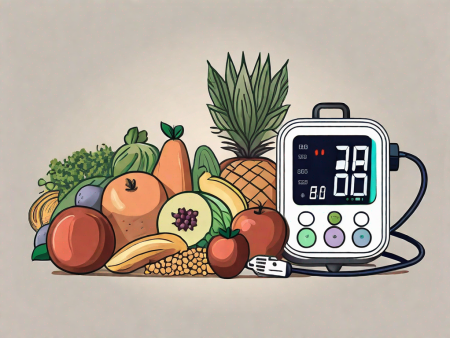Discover the importance of monitoring your blood pressure regularly and learn how often you should check it to maintain optimal health.
How Often Should You Check Your Blood Pressure?

Do you ever wonder how often you should check your blood pressure? It’s an important question that often gets overlooked. But fear not! In this article, we will guide you through the ins and outs of blood pressure monitoring and help you determine the ideal frequency for checking your levels.
Understanding Blood Pressure Readings
Before we dive into the nitty-gritty of checking your blood pressure, let’s first grasp the basics of blood pressure readings. Your blood pressure is measured using two values: systolic and diastolic. The systolic value represents the pressure in your arteries when your heart beats, while the diastolic value indicates the pressure when your heart is at rest.
Many people don’t realize the importance of regular blood pressure monitoring. But let us tell you—it’s crucial! Monitoring your blood pressure gives you valuable insights into your overall health and helps detect any potential issues early on.
When it comes to understanding blood pressure readings, decoding the systolic and diastolic values is essential. Ideally, your blood pressure should fall within the normal range, which is around 120/80 mmHg. The systolic value tells us how hard your heart is working, pumping blood throughout your body with each beat. On the other hand, the diastolic value determines how well your heart is resting between beats, indicating the pressure in your arteries during this resting phase.
By regularly monitoring your blood pressure, you can keep track of any changes and identify patterns that may require attention. If your blood pressure consistently exceeds the normal range, it could indicate hypertension or high blood pressure. This condition can put you at risk for heart disease, stroke, and other serious health problems. That’s why keeping an eye on those numbers is crucial!
Understanding the significance of blood pressure readings goes beyond just knowing the numbers. It involves recognizing the impact that these values have on your overall well-being. High blood pressure can strain your heart and blood vessels, leading to damage over time. By taking proactive steps to manage your blood pressure, such as adopting a healthy lifestyle and following your healthcare provider’s recommendations, you can reduce the risks associated with hypertension.
Moreover, blood pressure readings can provide valuable insights into your cardiovascular health. They can help identify any underlying conditions or risk factors that may require further evaluation or treatment. Regular monitoring allows you and your healthcare team to make informed decisions about your health, ensuring that any necessary interventions are implemented promptly.
Remember, blood pressure is not a static number—it can fluctuate throughout the day due to various factors such as stress, physical activity, and even the time of day. That’s why it’s important to take multiple readings over time to get a comprehensive understanding of your blood pressure patterns.
In conclusion, understanding blood pressure readings involves more than just knowing the systolic and diastolic values. It requires recognizing the importance of regular monitoring, the potential risks associated with high blood pressure, and the role these readings play in assessing your overall health. By staying informed and taking proactive steps to manage your blood pressure, you can prioritize your cardiovascular well-being and reduce the likelihood of developing complications.
Factors Influencing Blood Pressure
Now that we understand the importance of blood pressure monitoring, let’s explore some factors that can influence your blood pressure levels.
When it comes to blood pressure, age is a significant factor. As we age, our blood pressure tends to increase naturally. This is because our blood vessels become less elastic and more rigid over time, making it harder for blood to flow through them. Additionally, the walls of our arteries may thicken, further contributing to higher blood pressure levels. That’s why it’s important to monitor your blood pressure regularly, especially as you get older. By keeping tabs on those numbers, you can catch any potential issues early and take steps to maintain a healthy blood pressure.
Age and Blood Pressure
As mentioned earlier, age plays a crucial role in blood pressure levels. However, it’s essential to note that while age is a contributing factor, it doesn’t mean that high blood pressure is inevitable as you get older. By adopting a healthy lifestyle and managing other risk factors, you can still maintain optimal blood pressure levels even as you age.
Speaking of lifestyle, it’s time to delve into how our everyday habits can impact our blood pressure.
Lifestyle and Blood Pressure
Believe it or not, your lifestyle habits play a significant role in your blood pressure levels. Let’s start with diet. Consuming a diet high in sodium, saturated fats, and cholesterol can increase your blood pressure. On the other hand, a diet rich in fruits, vegetables, whole grains, and lean proteins can help lower your blood pressure. Additionally, excessive alcohol consumption can also raise your blood pressure, so it’s important to drink in moderation.
Exercise is another crucial aspect of maintaining healthy blood pressure levels. Regular physical activity helps strengthen your heart and blood vessels, making them more efficient at pumping blood. It also helps control weight, reduce stress, and improve overall cardiovascular health. Aim for at least 150 minutes of moderate-intensity aerobic activity or 75 minutes of vigorous-intensity aerobic activity per week.
Smoking is a habit that should be avoided at all costs when it comes to blood pressure. Smoking damages your blood vessels and increases your risk of developing heart disease. It also raises your blood pressure temporarily and can make it more challenging to control. Quitting smoking is one of the best things you can do for your cardiovascular health.
Health Conditions and Blood Pressure
Certain health conditions can affect your blood pressure. For example, diabetes can damage your blood vessels and lead to high blood pressure. Kidney disease can also contribute to hypertension as the kidneys play a crucial role in regulating blood pressure. Additionally, heart problems such as coronary artery disease can cause your blood pressure to rise.
If you have any underlying health conditions, it’s crucial to monitor your blood pressure regularly. This way, you can manage your condition effectively and prevent any potential complications. Working closely with your healthcare provider to control your blood pressure is essential for maintaining overall health.
By understanding the various factors that can influence blood pressure levels, you can take proactive steps to keep your numbers in check. Remember, blood pressure monitoring is not a one-time event but an ongoing process. Regular check-ups, healthy lifestyle choices, and proper management of underlying health conditions are key to maintaining optimal blood pressure levels and overall cardiovascular health.
Recommended Frequency for Blood Pressure Checks
Now that we’ve covered the essential factors influencing your blood pressure, you must be wondering, “How often should I check my blood pressure?” Well, wonder no more! We’ve got you covered.
Regular blood pressure checks are an important part of maintaining good health and preventing potential complications. The frequency at which you should check your blood pressure depends on various factors, including your overall health, any underlying health conditions, and your risk factors for hypertension.
For Healthy Individuals
If you’re generally healthy and have no underlying health conditions, checking your blood pressure once every two years may suffice. However, it’s always a good idea to monitor it more frequently, especially if you fall into any high-risk categories.
Being overweight or obese can increase your risk of developing hypertension, so it’s important to keep a close eye on your blood pressure. Additionally, having a family history of hypertension can also increase your risk, so regular monitoring is recommended.
While checking your blood pressure every two years may be sufficient for most healthy individuals, it’s important to listen to your body and consult with your healthcare provider if you notice any changes in your health or experience symptoms such as dizziness or headaches.
For Individuals with Hypertension
Individuals diagnosed with hypertension should monitor their blood pressure more regularly. It’s recommended to check it at least once a month or as advised by your healthcare provider.
Regular monitoring is essential for individuals with hypertension as it helps gauge the effectiveness of their treatment plan and ensures that their blood pressure remains within a safe range. By keeping a close eye on their blood pressure readings, individuals can make necessary adjustments to their lifestyle and medication regimen to maintain optimal blood pressure control.
It’s important to note that individuals with hypertension should also monitor their blood pressure at home using a reliable blood pressure monitor. This allows for more frequent monitoring and provides healthcare providers with valuable information to make informed decisions about treatment adjustments.
For Individuals with Other Health Conditions
If you have underlying health conditions like diabetes or kidney disease, monitoring your blood pressure becomes even more crucial. These conditions can significantly impact your blood pressure levels and increase your risk of developing hypertension.
Individuals with diabetes should aim to check their blood pressure at least once a month or as recommended by their healthcare professional. High blood pressure and diabetes often go hand in hand, and controlling both conditions is vital for overall health and well-being.
Similarly, individuals with kidney disease should closely monitor their blood pressure to prevent further damage to their kidneys. Regular blood pressure checks, along with proper management of kidney disease, can help slow down the progression of the condition and reduce the risk of complications.
Remember, regular blood pressure checks are an essential part of maintaining good health, regardless of whether you have any underlying health conditions. By monitoring your blood pressure regularly, you can take proactive steps to manage your health and prevent potential complications.
How to Check Your Blood Pressure at Home
Now that we’ve established the importance of regular blood pressure checks let’s talk about how you can monitor it from the comfort of your own home.
Choosing the Right Equipment
Investing in a reliable blood pressure monitor is key. Look for a device that is easy to use, accurate, and has a comfortable cuff that fits your arm properly. There are various types of monitors available, from manual ones to digital devices. Your healthcare provider can guide you in choosing the most suitable option for your needs.
Proper Technique for Accurate Readings
Getting accurate blood pressure readings requires proper technique. Make sure to follow the instructions provided with your monitor carefully. Sit in a quiet and comfortable environment, rest your arm on a table at heart level, and avoid any strenuous physical activity or consuming caffeine before taking the measurement. This will help ensure accurate and reliable results.
Interpreting Your Blood Pressure Results
Now that you have your blood pressure readings in hand, let’s decipher what they mean.

Normal Blood Pressure Range
The ideal blood pressure range is around 120/80 mmHg. If your readings consistently fall within this range, congratulations! Keep up the healthy habits and regular check-ups to maintain optimal cardiovascular health.
When to Seek Medical Attention
If your blood pressure readings consistently exceed or fall below the normal range, it’s essential to seek medical attention. Consult with your healthcare provider to discuss your readings and determine the appropriate course of action. They will be able to recommend lifestyle changes, medications, or further tests, if necessary, to keep your blood pressure in check.
Remember, monitoring your blood pressure regularly is a vital aspect of maintaining good overall health. By understanding the importance of regular checks and following the recommended guidelines, you’ll be well on your way to a healthier cardiovascular system. So, go ahead and take charge of your blood pressure—you’ve got this!






